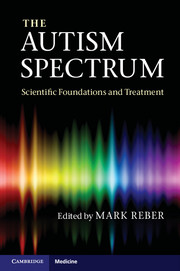Book contents
- Frontmatter
- Contents
- List of Abbreviations
- List of Contributors
- Preface
- Section 1 What We Know about Autism and How We Know It
- Chapter 1 Autism nosology
- Chapter 2 Epidemiology of autism
- Chapter 3 Developmental neuropsychology of autism
- Chapter 4 Neuropathology of autism
- Chapter 5 Etiology
- Chapter 6 Etiology
- Section 2 Assessing and Treating Children with Autism Spectrum Disorders
- Section 3 Assessing and Treating Adults with Autism Spectrum Disorders
- Index
- Plate Section
- References
Chapter 5 - Etiology
syndromic autism
from Section 1 - What We Know about Autism and How We Know It
Published online by Cambridge University Press: 05 November 2012
- Frontmatter
- Contents
- List of Abbreviations
- List of Contributors
- Preface
- Section 1 What We Know about Autism and How We Know It
- Chapter 1 Autism nosology
- Chapter 2 Epidemiology of autism
- Chapter 3 Developmental neuropsychology of autism
- Chapter 4 Neuropathology of autism
- Chapter 5 Etiology
- Chapter 6 Etiology
- Section 2 Assessing and Treating Children with Autism Spectrum Disorders
- Section 3 Assessing and Treating Adults with Autism Spectrum Disorders
- Index
- Plate Section
- References
Summary
This chapter and the following will consider etiologies of autism. In the present chapter, the focus will be on autism that occurs in well-described neurologic and genetic disorders – referred to here as secondary or syndromic autism and distinguished from primary, essential or idiopathic autism that occurs in people who have no additional diagnosable neurologic disorder. This chapter will focus on several specific neurogenetic syndromes that are associated with a high rate of occurrence of autism. The next chapter will move on to address a range of biologic processes that independently or in combination may lead to the social and communication deficits and behaviors that define autism. Both syndromic and essential autism are assumed to be etiologically heterogeneous.
In its heterogeneity, autism resembles intellectual disability (mental retardation), the other major neurodevelopmental disorder of childhood. Intellectual disability is also behaviorally defined (in terms of cognitive and adaptive delays) and is universally recognized to have many causes. According to Coleman and Betancur (2005), over 2000 disease entities have been described in persons with intellectual disability. In ASDs, the number of associated disease entities that have been reported in the literature is smaller – Coleman and Betancur indicated more than 60 – but this number is growing, particularly as new efforts are made to identify genetic variations that occur in autistic populations. Table 5.1 lists selected conditions that have been associated with autism. These include well-described neurogenetic syndromes, with and without stigmatizing features (congenital anomalies); congenital infections; toxic embryopathies; epilepsy syndromes; metabolic diseases; chromosomal abnormalities and single gene mutations. Most of these conditions involve prenatal (and some perinatal and early postnatal) insults to the developing nervous system.
- Type
- Chapter
- Information
- The Autism SpectrumScientific Foundations and Treatment, pp. 112 - 144Publisher: Cambridge University PressPrint publication year: 2012



